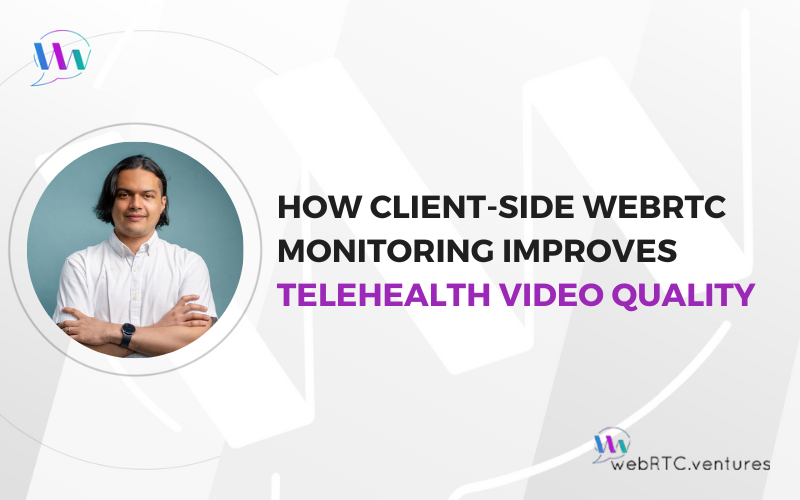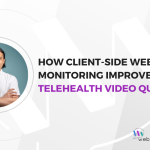WebRTC’s code may be open source and royalty-free, but deploying a reliable, production-grade real-time communications application involves both up-front development investment (engineering, integration, and setup) and ongoing operational spending (infrastructure, bandwidth, monitoring, and scaling). Teams who overlook either side risk major surprises as their product grows.
So how much does building and running a WebRTC application cost? The answer varies widely depending on your approach and your usage. Building your own solution (DIY) versus using a managed service (CPaaS) comes with fundamentally different cost structures and trade-offs. Teams often underestimate what it takes to build and run production-grade WebRTC infrastructure, from the specialized engineering talent required to the data transfer costs that can surprise you at scale.
In this guide, we’ll break down the real costs of building WebRTC infrastructure and running a production WebRTC application. We’ll walk through detailed calculations comparing three different approaches to hosting the same workload, and help you determine which path makes sense for your specific situation.
The Two Main Types of WebRTC Costs
When budgeting for a WebRTC project, your expenses fall into two primary categories: the upfront investment to build the product and the ongoing costs to run it.
WebRTC Development Costs (Upfront Investment)
These are the initial costs to get your application off the ground. They can vary dramatically depending on your approach, whether you’re using an in-house development team or hiring a third-party agency. While a full analysis of these costs is beyond the scope of this post, they primarily consist of:
- Human Capital: The salaries of the developers, DevOps engineers, and UI/UX designers who are actively building the application and its underlying infrastructure.
- Infrastructure & Tools: The costs for servers, databases, and services used during the development, testing, and debugging phases.
Operational Costs (Ongoing Expenses)
Once your application is live, you incur recurring operational costs to keep it running smoothly.
- Human Capital: The salaries for the team that maintains, monitors, and scales the application and servers. This is a significant long-term commitment as this highly skilled team is needed for the lifetime of the application.
Alternatively, you can leverage a Communications Platform as a Service (CPaaS) provider. These providers will handle some of these responsibilities and prorated into the service’s monthly fee. More on this in a minute.
- Usage Costs: These are the recurring costs for the cloud servers and, most importantly, the data transferred by your live application. Advanced AI features can increase compute requirements, so factoring them in early helps avoid surprises. These usage costs are the primary focus of this guide.
Infrastructure Costs: The Build vs. Buy Decision for Each Component
At the heart of your application is the real-time infrastructure. Here, you face a critical decision for each component: do you take a Do-It-Yourself (DIY) approach, or do you leverage a CPaaS?
Application Servers (Your Core Logic)
- You (or an outside development team) are always responsible for building and hosting your application server. This is the unique brain of your operation. It runs your specific business logic, manages user accounts, handles application data, and serves your front-end.
- How a CPaaS can help: A good CPaaS can dramatically accelerate the work of building your application server. Many providers offer pre-built front-end UI kits (like a pre-styled video grid), template applications, and powerful SDKs that simplify the integration between your application logic and their communication backend. This can save hundreds of hours of development time.
Signaling Servers (The Connection Manager)
- DIY Approach: You build, host, and scale your own signaling server, i.e. using WebSockets. This gives you complete control over the connection logic. However, it also adds significant complexity, another server to maintain, and another point of failure to manage.
- CPaaS Approach: With a CPaaS, your connections are completely managed by the provider. Their client-side SDK handles all signaling transparently. You don’t have to build, manage, or even think about this component; it’s bundled directly into their service.
ICE Servers (STUN/TURN for Connectivity)
- DIY Approach: You host your own STUN servers (which are lightweight and simple) and TURN servers (which can be expensive and bandwidth-intensive). When a user is behind a strict firewall, their media must be relayed through a TURN server. In a DIY setup, you are directly responsible for the significant data transfer costs of this media relay.
- CPaaS Approach: With a CPaaS, a globally distributed network of highly available STUN and TURN servers is included. This is one of the biggest hidden values of a CPaaS. They absorb the complexity and unpredictable bandwidth costs of media relay, ensuring your users can connect from anywhere.
Media Servers (SFU/MCU for Group Calls)
- DIY Approach: For any call with more than two people, you need a media server. In the DIY world, this means you deploy, manage, and scale open-source (like LiveKit or Janus) or commercial media server software on your own cloud instances. Your primary costs are the server compute resources and the massive amount of data transfer required to route video streams between participants. This requires deep WebRTC expertise to configure, optimize, and scale effectively.
- CPaaS Approach: Media servers are the core CPaaS business. They manage a globally distributed, auto-scaling fleet of media servers optimized for real-time communication. You don’t pay for the servers directly: you pay a simple per-minute fee for each participant connected through their infrastructure.
Data Transfer (The Biggest Variable Cost)
- DIY Approach: This is your most significant and unpredictable operational cost. You pay your cloud provider (like AWS, Google Cloud, or Azure) for every gigabyte of video and audio data that flows out of your media and TURN servers. A popular event or a single buggy client can lead to a shockingly high bill. An alternative solution is to host your infrastructure on-premise, but this introduces its own set of complexities.
- CPaaS Approach: When using a CPaaS, data transfer costs are abstracted away and bundled into a simple, predictable per-participant-minute pricing model. This protects you from surprise bandwidth bills and makes financial forecasting much easier.
Cost Calculation Showdown: A 4-Person Video Call
Choosing how to run your backend is one of the biggest decisions you’ll make. Do you build it yourself on a cloud provider, or do you use a managed service (CPaaS)? Let’s explore this by comparing three different ways to handle the same workload: hosting 100 simultaneous 4-person video calls (400 users total) for one hour.
Data Transfer Costs
In our examples below, you’ll see a data transfer figure of 420 GB. This is a simplified estimate based on the video streams in our scenario. Here’s the math behind it:
- Data to One Person: Each participant receives one high-quality stream (~1.5 Mbit/s) and three lower-quality streams (~0.3 Mbit/s each). That’s a total of 2.4 Mbit/s of data being sent to each person by the media server.
- Data for One Call: For a 4-person call, the media server sends data to all four participants, so we multiply: 2.4 Mbit/s x 4 people = 9.6 Mbit/s for the entire call.
- Data Volume per Hour: Converting this bitrate to a byte volume for one hour gives us approximately 4.2 GB of data transfer for a single call.
- Total Workload: Finally, we scale this to our full workload: 4.2 GB/call x 100 calls = 420 GB.
Now, let’s see how this data usage impacts the cost of our three architectures.
Scenario 1: The Smart Self-Hosted Build 🧠
This approach leverages performance testing to determine a “right-sized” infrastructure, designed by an experienced team focused on efficiency.
- Architecture: Testing revealed that 4 small, compute-optimized AWS servers (c5.2xlarge) are enough to host the calls. These are deployed close to users, in a US region with standard data rates ($0.09/GB).
- Cost Breakdown:
- Server Cost: 4 servers x $0.34/hour = $1.36
- Data Transfer: 430 GB x $0.09/GB = $37.80
- Total 1-Hour Cost: $39.16
This is the ideal self-hosted setup—lean, efficient, and highly cost-effective at scale, if you have the expertise to build and maintain it.
In addition, many other WebRTC optimizations can further reduce costs or improve quality. These range from simple tactics like audio-only modes to reduce traffic, to bitrate caps, and even advanced configurations (e.g., codec tuning, bandwidth estimation or redundancy settings).
Scenario 2: The Overprovisioned Self-Hosted Build 💸
This is what often happens without careful planning. The team mistakenly believes two massive servers are simpler to manage and deploys them far from users, in a more expensive region without checking data costs.
- Architecture: 2 huge, general-purpose AWS servers (m5.24xlarge) that are mostly idle. Deployed in South America with higher data rates ($0.15/GB).
- Cost Breakdown:
- Server Cost: 2 servers x $4.60 = $9.20
- Data Transfer: 420 GB x $0.15 GB = $63
- Total 1-Hour Cost: $72.20
This build is a costly mistake. The wrong server choice and high data fees make it almost twice as expensive as the smart build. Furthermore, hosting servers far from users will introduce significant latency, resulting in a poor user experience.
Scenario 3: The CPaaS Plan
This approach outsources the entire backend to a specialized provider like Daily or LiveKit. You don’t manage servers; you just pay for usage.
- Architecture: Fully managed by the provider who charges $0.004 per user/min.
- Cost Breakdown:
- Usage Cost: 400 users x 60 minutes x $0.004 user/min
- Total 1-Hour Cost: $96.00
This option offers zero infrastructure headaches, global scale from day one, and completely predictable, linear pricing.
The Final Showdown
| Scenario | 1-Hour Cost | Complexity | The Takeaway |
|---|---|---|---|
| 1. Smart Self-Hosted | $39.16 | High | The cheapest option on paper, but requires significant engineering expertise. |
| 2. Overprovisioned Self-Hosted | $72.20 | High | A cautionary tale of how easy it is to waste money without proper planning. |
| 3. CPaaS Plan | $96.00 | Low | The simplest, fastest path to market with predictable costs. |
Which WebRTC Path Is Right for You?
As this comparison shows, a well-optimized self-hosted (DIY) approach can yield the lowest infrastructure cost on paper. But that number doesn’t tell the full story. It excludes the ongoing investment in highly skilled WebRTC engineers required to build, maintain, and continuously optimize the system.
Here’s a practical way to decide:
When a DIY WebRTC Infrastructure Makes Sense
- You have an experienced in-house WebRTC team or are working with partners like our team at WebRTC.ventures.
- You need low-level control over your media pipeline or custom integrations for your use case beyond what a CPaaS allows.
- You’re operating at a large enough scale that optimizing infrastructure costs can translate into meaningful savings.
When a CPaaS Is the Better Fit
- You need to move fast and get to market quickly.
- You want predictable, usage-based pricing with minimal operational overhead.
- You prefer your developers to focus on your product’s unique value, not on real-time infrastructure management.
For most organizations, starting with a CPaaS is the most efficient and cost-effective way to launch a production-ready video application. As your application grows and your use cases become more complex, a hybrid or full DIY model can provide greater flexibility and cost control, especially when guided by experienced WebRTC architects.
Ready to build a cost-effective, scalable WebRTC application?
Whether you choose a CPaaS or a DIY architecture, our team of WebRTC development experts can help you make the right technical and financial decisions from day one.
We specialize in designing architectures that balance cost, control, and scalability. We customize CPaaS solutions to fit your workflow and brand experience, and we build and optimize DIY WebRTC infrastructure tailored to your performance and compliance needs. We also integrate AI and Voice AI capabilities to enhance your application’s functionality, efficiency, and user experience. And, we offer WebRTC testing and WebRTC managed services to make sure your applications runs smoothly.
From startups adding their first real-time feature to enterprises scaling millions of users, we’ve helped teams launch and grow production-ready WebRTC applications that deliver exceptional performance and user experience.
Let’s build your WebRTC application.
Further Reading:
- Why WebRTC Remains Deceptively Complex in 2025
- Streamlining WebRTC Development: Building a Video Chat App with a CPaaS
- Mastering STUN & TURN Servers: A Guide to Proper Integration for WebRTC Applications
- WebRTC Media Servers – SFUs vs MCUs
- Beyond WebRTC Projects: Build Your Complete Engineering Team











